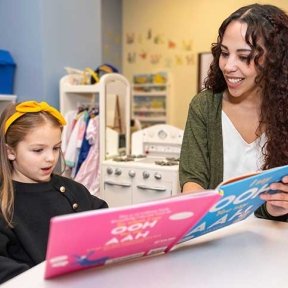About Child Language Disorders
Language is the system of rules that allow humans to communicate thoughts and ideas as well as express wants and needs. Language can take on many forms, such as gestures, speaking, reading, and writing.
Language in the Young Child
Children begin developing language at birth and continue developing language throughout childhood, adolescence and beyond. Early language development in young children serves as the foundation for future communication development, social skills, academic success, and overall life accomplishments.
The American Speech-Language-Hearing Association (ASHA) provides a list of communication milestones for typical developing children, birth through preschool.
Symptoms of a childhood language disorders can present in a number of ways. Children who have language difficulty may be challenged to understand language, receptive language problems; challenged to express their thoughts and ideas, expressive language problems; or have a combination of both receptive and expressive language difficulties. Language problems can also impact a child’s ability to interact socially with others or hinder their early literacy skills.
According to the American Speech and Hearing Association, signs or symptoms of preschool language disorders may include the following.
Receptive language problems, or difficulty with understanding language:
- Understanding gestures.
- Following directions.
- Answering questions.
- Identifying objects and pictures.
- Taking turns when talking with others.
Expressive language problems, or expressing thought and ideas:
- Asking questions.
- Naming objects.
- Using gestures.
- Putting words together into sentences.
- Learning songs and rhymes.
- Using correct pronouns, like “he” or “they.”
- Knowing how to start a conversation and keep it going.
Early reading and writing difficulties:
- Holding a book right side up.
- Looking at pictures in a book and turning pages.
- Telling a story with a beginning, a middle, and an end.
- Naming letters and numbers.
- Learning the alphabet.
Language in School-Age Children and Adolescents
ASHA also provides valuable information regarding the developmental communication milestones for school age children (kindergarten through 5th grade).
Children with language disorders in elementary school have been found to struggle with academic and literacy skills and these difficulties can continue throughout the early adolescent years and continue well into high school. Older children with language problems often display poor school performance, demonstrate difficulty reading, struggle in social situations, and continue to have difficulty understanding and expressing themselves using language.
Since language is such an important component of a child’s development, early intervention has been shown to be a key critical factor to improve the development of language in children. Child language treatment may include individual or small group therapy sessions that target the child’s specific area of language difficulty, such as vocabulary, sentence construction, following multi-step directions or social interaction skills. Therapy uses developmentally appropriate strategies and techniques that are personalized to meet each child’s individual learning style.
Dedicated to Service
Tips for Promoting Speech Development in Children
Midwestern University is dedicated to helping people learn and adapt to a healthier lifestyle. Learn helpful Tips for Promoting Speech Development in Children.
Top Tips for Reading to Your Children
Cindy Krizizke, one of Midwestern's Speech Language Pathologists, discusses several tips that can help children improve their ready skills.



